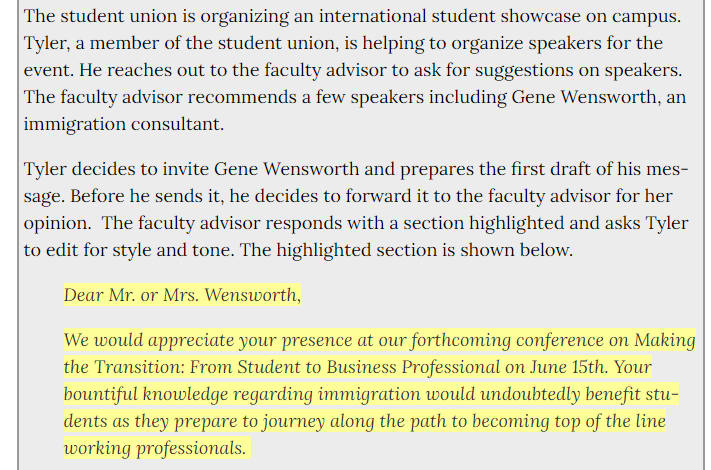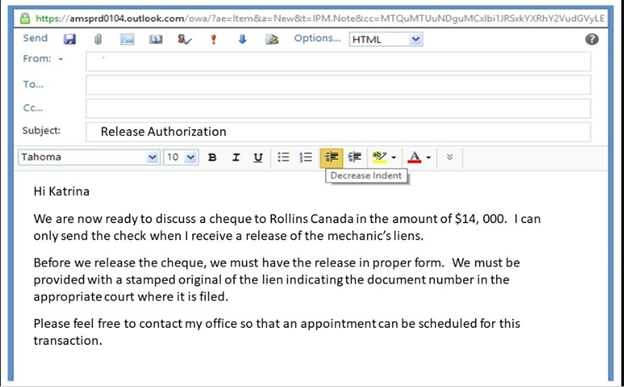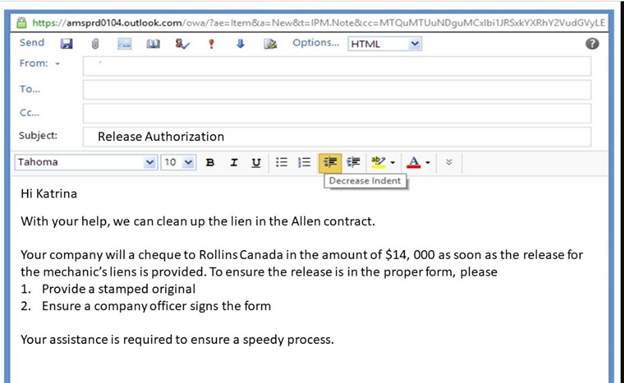30 Plain Language: Tone and Inclusivity
Learning Objectives
After you complete this chapter, you will be able to
- write using a professional, confident, and conversational tone
- choose words with the correct formality
- use contractions where appropriate
- use personal pronouns where appropriate
- chose positive or neutral phrasing to stress reader benefits
- use inclusive terms
Being concise does not mean being rude. Your writing should be conversational and friendly yet professional. Watch this video for an overview of how to use tone to help you effectively communicate with your audience:
Use a Conversational Tone
Tone refers to the level of formality or friendliness that a message has. Most business correspondence should be polite, professional, and conversational – not stiff and formal and certainly not rude or sloppy. The right tone is created by using the right words.
Choose the Right Words
Information in this section has been adapted from Unit 5: Analyzing your Audience in Communication at Work by Karen Vance (Kwantlen Polytechnic University)[1], made available by Pressbooks under a CC By 4.0 license
Word choice is called “diction”. The words used when writing to a co-worker should be different from the words used when writing to your manager or a customer. The table below provides words choices that reflect informal, semi-formal and formal language. Understanding the audience will ensure your choice of words is always right for the situation.
| Informal / Slang | Semi-formal / Common | Formal / Fancy |
| kick off | begin / start | commence |
| cut off | end | terminate |
| put off | delay | postpone |
| awesome / dope | good | positive |
| crappy / shoddy | bad | negative |
| flaunt | show | demonstrate |
| find out | discover | ascertain |
| go up | rise | increase |
| fess up / come clean | admit | confess |
| mull over | consider | contemplate |
| bad-mouth / put down | insult / belittle | denigrate |
| plus | also | moreover |
| jones for | need | require |
| put up with | endure / suffer | tolerate |
| leave out / skip | omit | exclude |
| give the go-ahead / green light | permit | authorize |
| loaded / well-heeled | wealthy / rich | affluent / monied |
| deal with | handle | manage |
| pronto / a.s.a.p. | now | immediately |
| muddy | confuse | obfuscate |
Learning Check
Use Contractions and Personal Pronouns
Information in this section is adapted from The Plain Language Action and Information Network (PLAIN)[2]
Contractions are words that are joined with an apostrophe to “contract” or make the two words into one short word. Examples include can’t, doesn’t, don’t, hasn’t, it’s, she’s, won’t, etc.
Pronouns are words that take the place of nouns: he, she, it, etc. First-person pronouns used to refer to yourself include I, me, mine, my, we, and our. Second-person pronouns to refer to the person you are speaking to are you, your, and yours.
While the use of contractions and first- and second-person pronouns is often not acceptable in formal academic writing, business writing should be more personal and conversational. A good guideline is to “write as you talk”.
Use contractions wherever they sound natural and use first- and second-person pronouns (I, we, you) to speak directly to readers.
Impersonal: No pilot in command of a civil aircraft may allow any object to be dropped from that aircraft in flight that creates a hazard to persons or property.
Personal: When in command of a civil aircraft, you must not allow anyone to drop any object from that aircraft in flight that creates a hazard to persons or property.
Impersonal: Copies of agency records are available to the public at regional and district offices.
Personal: You can get copies of agency records at the regional or district offices.
Learning Check
Try this revision activity by Venecia Williams (BCcampus)[3]. How can Tyler revise this part of his message so that he uses more concise language and a more appropriate tone? What general advice would you give to Tyler?

Use Positive Phrasing and a “You Attitude”
Focus on what the reader can do instead of on what they can’t do. Avoid using words with negative meanings or connotations and, where possible, make sure the reader understand how your message benefits them.
Negative: You cannot use your college email until you have a username and password.
Positive/Neutral: You may use your college email once you have a username and password.
Negative: By neglecting the posted no parking signs, you committed a parking violation.
Positive/Neutral: Please obey the posted parking regulations.
Negative: Any failure to include citations will result in a zero score.
Positive/Neutral: You must include citations in order to receive a score.
If you must give negative news, you can soften it by putting it into a dependent clause at the beginning of your sentence. Your reader will automatically focus more on the information in the independent clause, so be sure to include neutral or positive information after the comma.
Negative: I cannot increase your score on the assignment.
Less Negative: Although I cannot increase your score on the assignment, you can earn additional points by completing the extra credit assignment explained in the syllabus.
Avoid overusing “I”. Using “I” too much can put the focus on the message on you instead of on your reader. In some cases, to remove the “I”, you will need to use a passive voice. Where possible, explain to the reader how your message benefits them.
Focus on Writer: I am inviting all post-diploma students to an APA workshop.
Focus on Benefits to Reader: Post-diploma students may attend a workshop where they will learn how to use APA documentation techniques for upcoming papers.
Focus on Writer: The college wants all faculty to submit their vacation requests before the end of the year.
Focus on Benefits to Reader: To ensure that your vacation request can be approved, please submit your vacation request before the end of the year.
Watch the following video from GreggU[4] on how to use the “you attitude” in your writing:
Learning Check
Try this practice by Karen Vance (Kwantlen Polytechnic University)[5], shared under a CC By 4.0 license.
Read the following two email examples and answer the questions that follow. Click on each image to make them bigger if needed.
Use Inclusive Terms
The information in this section is adapted from Queen’s University’s Style Guide[6].
Inclusive language respects and promotes all people as valued members of society. It uses vocabulary that avoids exclusion and stereotyping and is free from descriptors that portray individuals or groups of people as dependent, powerless, or less valued than others. It avoids all sexist, racist, or other discriminatory terminology.
Guiding Principles:
- Use person-centered language.
- Be respectful of a person or group’s preference regarding vocabulary and be guided in your writing by that preference.
- Remember there is a difference between respectful and appropriate language for those belonging to a group (in-group) and those who don’t belong (out-group). For example, a person may have reclaimed a once-derogatory term and may now use this term. The same term, however, may offend when used by someone from outside that specific community.
- Anticipate a diverse audience and make conscious efforts to reflect that diversity in written work and images. Take into consideration the different cultural, ethnic, religious, or racial backgrounds your audience may have, as well as the different ages, gender and sexual orientations, and disabilities, visible or not, of all people.
- Avoid using descriptors that refer to a person’s race, gender, sexual orientation, disability, or age, unless those descriptors are relevant to the story.
Abilities/Disabilities
The person, not the disability, should always come first. Use language that emphasizes abilities and conveys a positive message rather than focusing on a person’s limitations or disabilities.
Use the following:
- a person with a disability; persons with a disability (not people)
- students/employees/faculty members with a disability
- a person with cystic fibrosis
Indigenous Peoples
There are three distinct groups of Indigenous Peoples in Canada: First Nations (status and non-status Indians), Inuit, and Métis.
Where possible, avoid using the terms Aboriginal People, Native People, or First Nations People, as they do not encompass the separate origins and identities of the various groups. Native is a word similar in meaning to Aboriginal but is increasingly becoming outdated. The term Indigenous is now widely accepted and can be used interchangeably with Aboriginal Peoples. Capitalize both Aboriginal and Indigenous.
First Nation or Nations is widely accepted and has generally replaced the term Indian (although some individuals still prefer to be called Indian, it is generally not appropriate for a non-Indigenous person to use this term unless referring to individuals from India). First Nation(s) is widely used by status and non-status Indians (as described in the Indian Act). This term does not include Métis and Inuit people.
First Nations people come from different areas or Nations and have distinct cultures, languages and traditions. When possible, avoid referring to First Nations people as a homogeneous group. Include someone’s specific Nation, community, or band (use the spelling the band prefers). For example, Thunder Bay is located in the traditional territories of the Anishinaabe people, which includes includes members of the Ojibwe, Odawa, Potawatomi, Mississaugas, Nipissing, and Algonquin peoples.
Canadian Press notes that the word Métis originally applied to descendants of French traders and trappers and Aboriginal women in the Canadian northwest. Now it is usually taken to mean anyone of mixed Indian and European ancestry. Many Canadians have this mixed ancestry but not all describe themselves as Métis.
The Inuit population lives in small settlements above the treeline from Labrador to Alaska. Inuit make up 85 per cent of the population of the territory of Nunavut. The singular of Inuit is Inuk. Their language is Inuktitut. Do not use the term Eskimo.
Gender and Sexual Orientation
Use inclusive, gender-neutral terms rather than those that make sex distinctions.
- humankind, not mankind
- staffing the office, not manning the office
- ancestors, not forefathers
- working hours, not man hours
- artificial, synthetic or constructed, not manmade
The gender identity of an individual may not conform to social expectations about gender based on anatomy and appearance, or to the gender assigned that individual at birth. Be aware that some individuals identify themselves as transgender and that some individuals do not identify with the “gender binary” at all; that is, they do not identify themselves as being male or female, man or woman. Where it is not clear what, if any, gendered pronouns or nouns may be appropriately used for an individual, ask that individual and respect the individual’s wishes. Some individuals may prefer the use of recently constructed sets of gender-neutral pronouns or to substitute plural pronouns (they, their, them) for the singular, gendered one.
Be mindful of the appropriate terms (for example, 2SLGBTQ+ – 2 Spirit, Lesbian, Gay, Bisexual, Transgender, Queer). Use the phrase sexual orientation, not sexual preference.
Race and Ethnicity
Avoid generalizations and stereotyping based in race or ethnicity. Be respectful of all cultural backgrounds and be inclusive in recognizing the diversity at Queen’s University. Avoid identifying people by race, colour, or national origin, unless it is appropriate for context, and do not assume that a person’s appearance defines their nationality or cultural background.
Capitalize the proper names of nationalities, peoples, and races: Aboriginal Peoples, Métis, Cree, Inuit, Arab, French-Canadian, Jew, Latin, Asian.
Terms such as “visible minority” and “person of colour” are increasing becoming more outdated and inaccurate. If relevant, use the following terms to describe persons or groups: “racialized person,” “member of a racialized group,” or “racialized group.”
Be aware that the gender identity of an individual may not conform to social expectations about gender based on anatomy and appearance, or to the gender assigned that individual at birth. Some individuals identify themselves as transgender and that some individuals do not identify themselves as being male or female, man or woman.
Also, a person’s name does not always suggest what gender they identify with (for example, Pat, Sam, and Taylor are names that are common for both males and females). Some email signatures indicate which pronoun (he, she, or they) a person prefers.
Where it is not clear what, if any, gendered pronouns or nouns may be appropriately used for an individual, ask that individual and respect the individual’s wishes or use the plural “they”. Most importantly, respect the preferences of the individuals or groups concerned.
Learning Check
Refer to The Government of Canada’s “Quick Reference Sheet” for additional examples of inclusive writing techniques.
CHECKLIST | Tone Guidelines
❑ Have you used a conversational tone?
❑ Have you used positive or neutral language and stressed reader benefits?
❑ Have you use words and phrases with positive or neutral connotations?
❑ Have you stressed reader benefits?
❑ Have you used inclusive language?
- Vance, K. (n.d.). Communication at work (adapted for KPU from Jordan Smith's (n.d.) Communication @ work). https://kpu.pressbooks.pub/communicationsatwork/ ↵
- The Plain Language Action and Information Network (PLAIN). (2011, May). Federal Plain Language Guidelines, revision 1 (pp. 27, 30). https://www.plainlanguage.gov/media/FederalPLGuidelines.pdf ↵
- Williams, V. ( n.d.) Chapter 3: Style and tone. In Fundamentals of business communication. https://pressbooks.bccampus.ca/businesswritingessentials/chapter/ch-4-style-and-tone/. CC BY-NC-SA 4.0. ↵
- GreggU. (2018, December 12). You attitude in business writing [Video]. YouTube. https://www.youtube.com/watch?v=mJK7hMXehj0 ↵
- Vance, K. (n.d.). Communication at work (adapted for KPU from Jordan Smith's (n.d.) Communication @ work). https://kpu.pressbooks.pub/communicationsatwork/ ↵
- Queen's University. (n.d.). Inclusive language. In Style guide: Writing style. https://www.queensu.ca/brand-central/writing-style/inclusive. ↵
Transgender people have a gender identity or gender expression that differs from the sex that they were assigned at birth. Some transgender people who desire medical assistance to transition from one sex to another identify as transsexual. Transgender, often shortened as trans, is also an umbrella term; in addition to including people whose gender identity is the opposite of their assigned sex, it may also include people who are non-binary or genderqueer. Other definitions of transgender also include people who belong to a third gender, or else conceptualize transgender people as a third gender.



